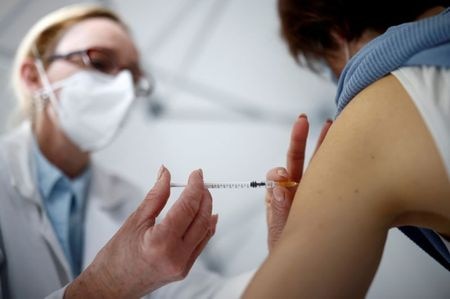Analysis: Which demographics are still dying of Covid-19 the most?

The UK’s immunisation programme is well underway, with 80.4 per cent of the population over the age of 16 receiving their second dose as of today, according to official government data.
Despite immunisation rates steadily increasing, the number of deaths in the week to 27 August jumped 17.8 per cent to 649 across the country, so which demographics are still being hit the hardest?
Age
According to the Office for National Statistics (ONS), positivity rates were topped by teenagers and young adults, however, hospital admissions and deaths were highest among the elderly.
Slightly more people aged 75 to 84 died of Covid-19 in the week to 22 August, than those 85 and over.
The same can be said for the aged 45 to 64 cohort, who were found to be dying of the virus more than their 65- to 74-year-old peers.
Ethnicity
Most ethnic minority groups have a higher risk of death involving the virus than those of white British background – a trend that has been seen throughout the pandemic, particularly in its early stages.
However, the patterns of infections leading to death by ethnicity have changed over the course of the pandemic, according to the ONS.
In the first wave of the pandemic, which began around late January to 11 September last year, people of Black and South Asian ethnic background had a “substantially higher risk of death” compared with those of a white British background.
While in the pandemic’s second wave, what ONS records as 12 September 2020 onwards, people of Bangladeshi and Pakistani background were “particularly at risk”.
Those in the Black community also remained at a “higher risk” in the second wave, in comparison to those who are white British.
Pre-existing health conditions
Those classed as ‘clinically vulnerable’ with pre-existing health conditions have been prioritised throughout the vaccine rollout, due to people in this group having higher death rates.
In the months between April and June this year, diabetes was the most common pre-existing condition among Covid-19 deaths in England and Wales, data from ONS revealed.
Hypertensive, or high blood pressure, diseases, diseases of the lung and coronary heart disease, were some of the most common pre-existing health conditions found in virus deaths.
At the beginning of the year, however, Dementia and Alzheimers were the second most common pre-existing conditions found in virus deaths, but have since dropped down to joint seventh.
There is not yet any new data yet from June onwards.
Region
Across England’s nine regions, Yorkshire and The Humber (100) recorded the most deaths in the week to 20 August, the ONS found, an increase of 22 more deaths each.
The North West (90) saw the second most deaths, followed by the West Midlands (82) and London (81).
The North East and South West recorded the least number of deaths in that week, as the North East recorded a large decrease from the previous week.
However, the number of registered deaths involving Covid-19 sank in five of the nine regions, signalling the slowing down of deaths from the virus as the UK’s vaccination programme steams ahead.
Communities in these cities may be less able to socially distance due to factors like commuting via public transport.
Areas with poorer broadband access, higher crime rates and less green space are also often found to be more socio-economically disadvantaged.
But a report published by the British Medical Journal last year concluded that “People living in more socio-economically disadvantaged neighbourhoods and minority ethnic groups have higher rates of almost all of the known underlying clinical risk factors that increase the severity and mortality of Covid-19, including hypertension, diabetes, asthma, chronic obstructive pulmonary disease (COPD), heart disease, liver disease, renal disease, cancer, cardiovascular disease, obesity and smoking.”
Which suggests why Covid-19 deaths may be higher in these regions, as opposed to the South West.
Vaccinations
The Covid-19 vaccines were long-hailed as a way out of lockdowns and the pandemic and they have managed to sever the link between very high case loads and high deaths in the UK.
Public Health England data for the two weeks to 3 September found that 1,091 vaccinated people and 536 unvaccinated people died of the virus, according to PHE data.
Similar results were published at the end of July, which prompted anti-vax sites to deter their following from getting the vaccines.
However, with the success of the UK’s immunisation programme, which prioritised ‘high risk’ individuals, it is expected that there will be an increasing number of vaccinated people dying of the virus, as the number of vaccinated increases.
For example, if 100 per cent of the UK population is vaccinated, then 100 per cent of Covid deaths would be made up of those who are vaccinated.
A PHE spokesperson confirmed to City A.M.: “In the context of very high vaccine coverage in the population, even with a highly effective vaccine, it is expected that a large proportion of cases would occur in vaccinated individuals, simply because a larger proportion of the population are vaccinated than unvaccinated.
“This may be even more notable if vaccination has been prioritised to individuals who are more susceptible or more at risk of severe disease.
“This is the case with the UK vaccination programme, in particular when looking at severe disease outcomes such as hospitalisations or deaths.”
The spokesperson added that those in risk groups, which have been prioritised in the immunisation programme, “may also be more at risk of hospitalisation or death” for reasons other than Covid-19, “and thus may be hospitalised or die with Covid-19 rather than because of Covid-19.”
Meanwhile, 12,300 unvaccinated people over the age of 50 were admitted to emergency care after contracting the Delta variant, according to PHE, and 2,118 people who were fully vaccinated were admitted.
PHE analysis found that 99 per cent of cases since July have been the Delta variant, which is 2.6 times more likely to hospitalise those who contract it.